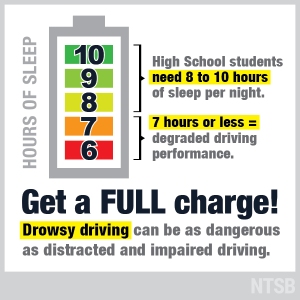By Stephanie Shaw
It’s hard to think of back-to-school season as anything other than an exciting new beginning. A new school year means new opportunities to learn, grow, and gain some independence; it’s also a new chance to make safe and healthy choices on and off the roads. The choices you make to achieve optimal health and safety can be simple—small changes to your everyday routine can create the greatest impact!
Guarantee a safe start to the school year by adopting a safety strategy that ensures you are rested, informed, and protected on and off the road. We’ve created some strategy tips for you that will contribute to a safe and healthy school year.
- Ride the school bus as often as possible.
Did you know that students are 70 times more likely to get to school safely when taking the school bus than when traveling by car? The school bus is the safest method for getting to and from school and, when possible, it should be your preferred method of transportation. Before stepping foot on your journey to the bus stop, refresh your knowledge of safe school bus practices. Sit facing forward in your seat when the vehicle is in motion, buckle up if the bus is equipped with seat belts, and be aware of traffic on the roads when it’s time to hop off.
- Get 8 to 10 hours of sleep every night.
 Although extracurriculars are important, don’t forget to factor sleep into your schedule after the school day is over. Research shows that teens should get between 8 and 10 hours of sleep each night to guarantee they feel rested and refreshed for school in the morning. Make sleep a top priority on your schedule! Be sure to set bedtimes and stick to them. Checking your cellphone, watching television, and searching the Web on your laptop disturbs your sleep patterns and contributes to insufficient or interrupted sleep. If good grades and great school days are something you hope to achieve this school year, uninterrupted, quality sleep is key.
Although extracurriculars are important, don’t forget to factor sleep into your schedule after the school day is over. Research shows that teens should get between 8 and 10 hours of sleep each night to guarantee they feel rested and refreshed for school in the morning. Make sleep a top priority on your schedule! Be sure to set bedtimes and stick to them. Checking your cellphone, watching television, and searching the Web on your laptop disturbs your sleep patterns and contributes to insufficient or interrupted sleep. If good grades and great school days are something you hope to achieve this school year, uninterrupted, quality sleep is key.
- Avoid all distraction on your morning and afternoon commute.
If you drive to and from school, remember that driving safely requires all your attention. Between 2014 and 2015, fatalities in distracted-driving–affected crashes increased by over 8%. Send your text messages, make phone calls, set your music playlist, and mute your cellphone before you put the key in the ignition. It’s also important to keep your morning routine activities in the house and off the road. Eat breakfast at the table, not in the driver’s seat, and put your makeup on in the bathroom mirror, not the rearview mirror. To reduce crashes, injuries, and deaths, you must disconnect from all distractions and focus all your attention on the road.
- Limit the number of passengers in the car on your way to and from school.
Extra passengers in the car create distractions. Driving with friends significantly increases the risk of a crash, which is why it’s important to limit the amount of people in your car as much as possible. Statistically, two or more peer passengers more than triples the risk of a fatal crash when a teen is at the wheel. You may become distracted by your peers’ conversations or actions in the car, and you may also be influenced to engage in risky driving behaviors when you know you’re being observed by others. Avoid driving with extra passengers, and you’ll avoid an extra distraction on the road.
Just a few simple changes to your daily routine can create a safer environment for you and your peers. Not only will these small changes help you achieve and succeed this coming school year, but you’ll also be creating safer roads for your family, friends, and community.
More Resources:
National Highway Traffic Safety Administration (NHTSA)
National Organizations for Youth Safety (NOYS)
Students Against Destructive Decisions (SADD)
Family, Career and Community Leaders of America (FCCLA)
Governors Highway Safety Association
Stephanie Shaw is a Safety Advocate in the NTSB Office of Safety Recommendations and Communications.
